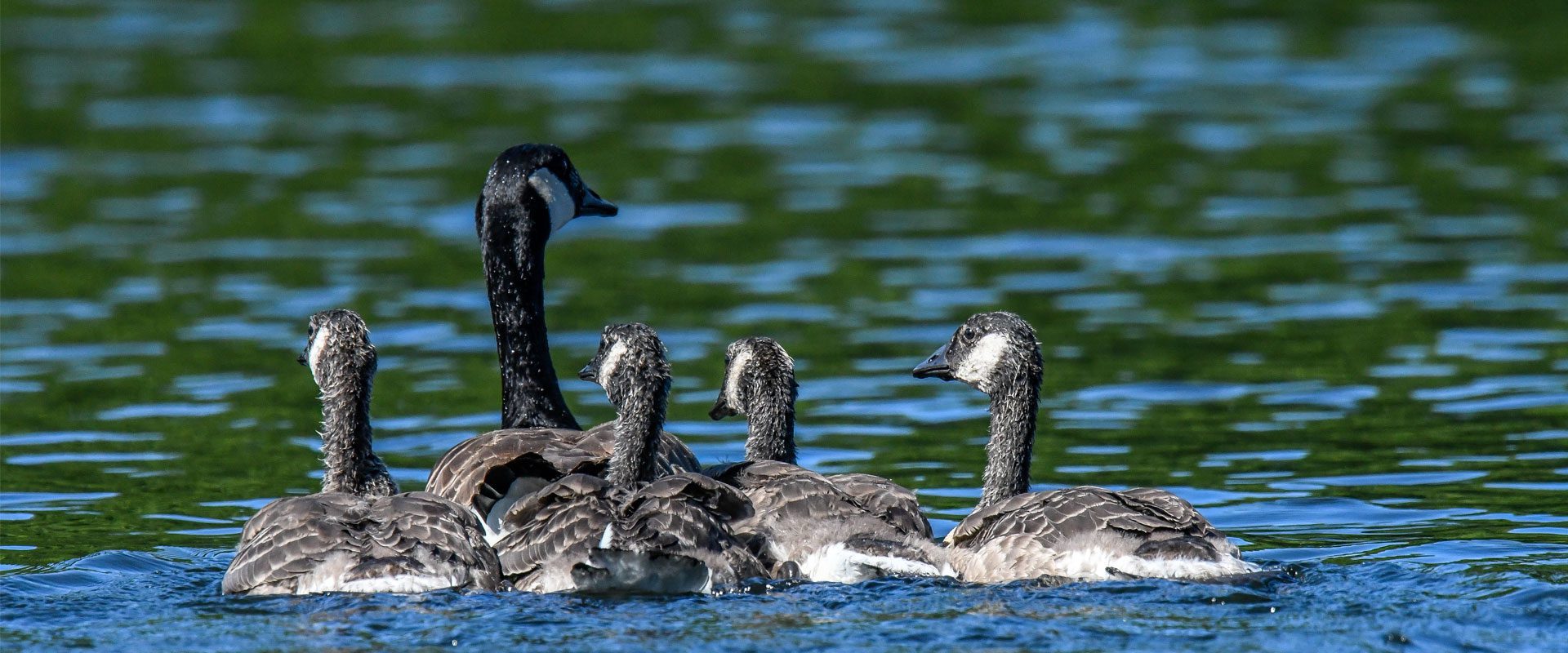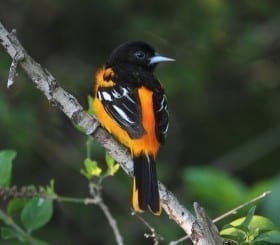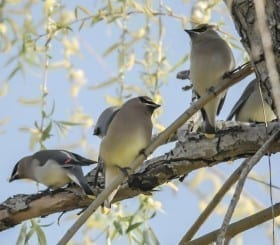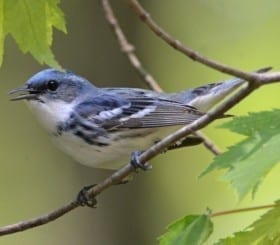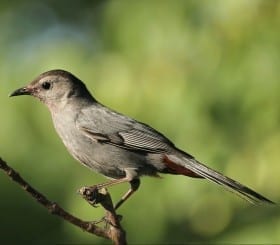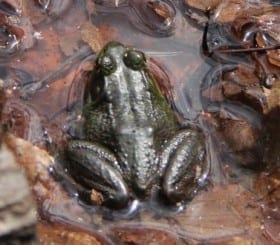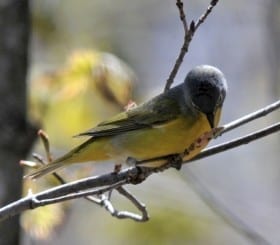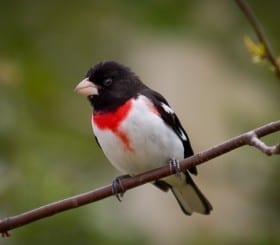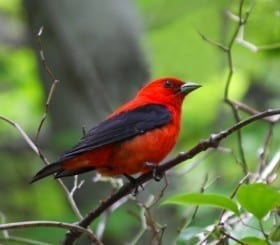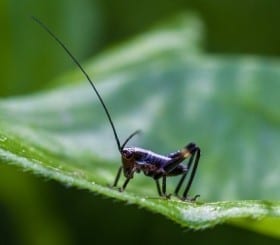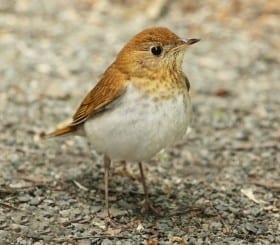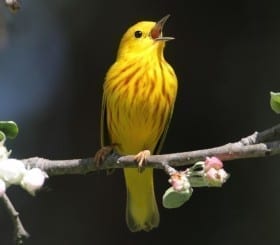These audio recordings of Forest animals were made by Martha J. Fischer of the Cornell Lab of Ornithology, with assistance from Consortium scientist Dr. Terryanne Maenza-Gmelch of Barnard College. The full set of recordings belongs to the Macaulay Library of the Cornell Lab of Ornithology, and we are delighted to feature abbreviated versions here, along with field notes and tips on identification from Dr. Maenza-Gmelch.
Baltimore Oriole
Icterus Galbula
The clear and sweet whistle of the Baltimore oriole is heard in this recording from the open forest near Sphagnum Pond. This bird is easily recognized by brilliant orange plumage. It lives in Black Rock Forest during the breeding season and then migrates to Florida, the Caribbean, Central America, or the tip of South America. At the beginning of this recording, you also hear an eastern towhee, an eastern chipmunk, the call note of a downy woodpecker, a scarlet tanager in the distance, and some West Point artillery, also in the distance.
Cedar Waxwing
Bombycilla cedrorum
Cedar waxwings travel around in groups and announce their presence by making high-pitched nasally whistles that often sound like baby birds. They prefer to eat fruits of forest trees and shrubs in the fall and insects in the summer. Cedar waxwings are year-round residents of Black Rock Forest. These beautiful birds are artfully described on allaboutbirds.org as a “silky, shiny collection of brown, gray, and lemon-yellow, accented with a subdued crest, rakish black mask, and brilliant-red wax droplets on the wing feathers”.
Cerulean Warbler
Setophaga cerulea
The cerulean warbler is a species of special concern in New York State because populations have been declining due to forest fragmentation and habitat loss. It is one of the most exciting birds to find at Black Rock Forest because of its rarity and beauty. The bird in this recording was singing from high in the canopy near the trout pool on White Oak Road. Its song is described as “buzzy notes ending in a higher pitched trill, ‘zee zee zee zizizizi eeet,'” on allaboutbirds.org.
Chestnut-Sided Warbler
Setophaga pensylvanica
The location of the chestnut-sided warbler at Black Rock Forest changes over the years because it prefers early successional forest. At the time of this recording, June 9th, 2011, the vegetation near the Stone House and Two Gates was at the perfect stage to satisfy the needs of this bird. Listen to the interesting vocalization often described as “pleased, pleased, pleased to meetya”. Look for a beautiful, yellow-capped, black and white bird with chestnut sides when you hear this sound.
Eastern Towhee
Pipilo erythrophthalmus
The male Eastern towhee is a boldly patterned black, white and rufous colored bird, while the female, is brown, white and rufous; it prefers areas of the forest with thick underbrush. This bird easily becomes a favorite because of its amusing song which is commonly described as “drink your tea.” The adult male towhee in this recording is singing from the brushy areas near the Stone House, where it can be reliably found during breeding season.
Eastern Wood-Pewee
Contopus virens
Who cannot love a bird that says its name? The Eastern wood-pewee, in this recording from the trail between Jim’s Pond and the Stone House, sings “pee-a-wee.” It is one of the many flycatcher species at the forest. This bird spends the winter in northwestern South America.
Gray Catbird
Dumatella carolinensis
Many students are surprised to learn that the meow sound coming from the bushes is, in fact, the gray catbird. This bird of shrubby areas is common at the Forest and is a prolific vocalist. In fact, it can be distracting when trying to listen for other birds! Catbirds are mimics similar to mockingbirds. They are easy to identify by the gray body, black cap and rusty feathers under the tail. The bird in this recording sang from the shrubs near the Stone House. Gray catbirds can be found in Orange County from March till November.
Gray Tree Frog
Hyla versicolor
The guttural trills of gray treefrogs are often mistaken for bird songs when they call during the day. However, they mostly call at night. Their skin color can change to match their surroundings. If you get to see one up close, be sure look at the interesting suction pads on their toes and the bright orange coloration on the hidden surfaces of the legs. These frogs are hard to find as they live in the trees, expertly camouflaged, during the day and descend at night.
Great Crested Flycatcher
Myiarchus crinitus
When the great crested flycatcher returns to the Forest in the spring from its wintering grounds in the tropics, it is difficult not to notice. This bird goes to the highest branch on a tree and makes two loud, short whistles. Once you learn this song, you can keep track of where this bird is in the Forest. If you are lucky enough to see it in good lighting, you will notice the gorgeous tones of rusty brown, yellow and gray.
Green Frog
Rana clamitans
The vocalization of the green frog is often described as sounding like a plucked banjo string. It is commonly heard near the ponds in the Forest. This one was recorded near Jim’s Pond with a veery and a scarlet tanager singing in the background. When you see the green frog, notice the length of the dorsolateral ridge: this is a linear fold of skin that runs from the eye down the back. (On the bull frog, this ridge is short and stops just behind the eye.) The male green frog has a yellow throat and a swollen thumb.
Nashville Warbler
Oreothlypis ruficapilla
The Nashville warbler is a small bird most easily identified by its gray head, yellow throat and white eye-ring. This bird is a fast-moving forager and is sometimes difficult to see. The song of the Nashville warbler was described as “a two-parted seebit, seebit, seebit, seebit, tititititititi” by Roger Tory Peterson. This recording was made during the breeding season near the brushy areas at Two Gates.
Rose-breasted Grosbeak
Pheucticus ludovicianus
While walking through the Forest, you may hear sounds like sneakers squeaking on a gymnasium floor. These are the call notes of the rose-breasted grosbeak. Take a few minutes to look and listen and maybe the bird will sing its rich whistle-like song. You may even get to see this boldly colored black-and-white bird with a rose-colored chest. In the fall, you can commonly see this bird feeding in trees with fruits, such as dogwoods, cherries and sassafras, which are a good source of energy to fuel the trip back to the tropics for the winter.
Scarlet Tanager
Piranga olivacea
Could the scarlet bird with black wings be the most beautiful bird in the forest? Many would say yes. This migratory bird comes to the Forest each spring from northwestern South America. It requires large tracts of forest for breeding success, and so it does very well at Black Rock Forest. It is most often heard rather than seen because it likes to stay high up in the canopy eating caterpillars and other insects. The sound in this recording is described as a robin with a sore throat.
Spring Field Cricket
Gryllus veletis
Crickets are insects in the order Orthoptera. This cricket was recorded in the evening at the Stone House. It was calling from the grasses while frogs were singing in the distance. Male crickets usually sing to attract females. The distinctive sound is produced when the insect rubs its wings together. This is a different mechanism of song production compared to birds and frogs, which produce vocalizations by passing air through special organs in their airways.
Veery
Catharus fuscescens
An early morning or evening walk around the Forest during the bird breeding season is a great experience. Perhaps you have heard the ethereal, downward spiraling, flute-like song of the veery. The veery is a thrush, and is related to other talented singers like the American robin, wood thrush and the hermit thrush. The veery leaves the Forest in the fall for its wintering grounds in South America and returns to us in the spring. This recording was made on White Oak Road near Two Gates.
Yellow Warbler
Setophaga petechia
Yellow warblers are easy to recognize since they are mostly yellow with some orange-brown streaking on the chest. Their song “sweet sweet a little more sweet” is heard near young woodlands and shrubby areas in the Forest, which is the preferred habitat of this bird. Yellow warblers, like most other warblers, are neotropical migrants.
